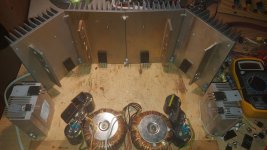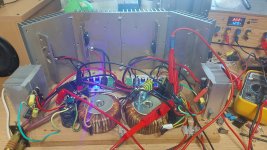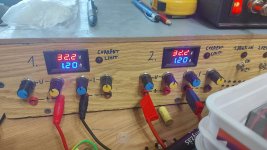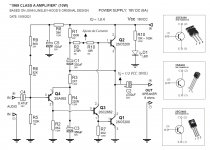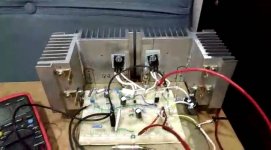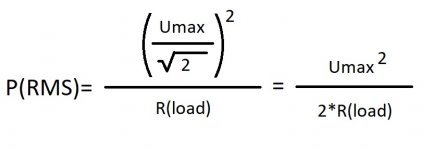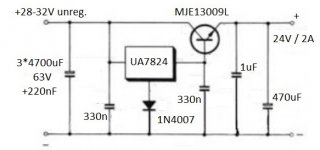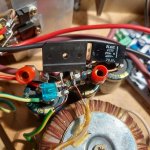Hello OldDIY!2N3773 are well suited for power supplies. 2SC2625 have low Hfe.
2N3055(ST/MOT) unuseable for audio?
You really need something with a tighter and better specification than 2SD882 as the driver. Depending on the manufacturer and lot, they could be OK or rather poor and sluggish because Hfe and Ft varies widely.
If you can't find original types, try the obsolete 2SD669AC or even 2SD667AC as the driver transistor, since it does influence the sound quality and even the Chinese copies of this one (there are at least 4 versions) should be more acceptable.
If you can't find original types, try the obsolete 2SD669AC or even 2SD667AC as the driver transistor, since it does influence the sound quality and even the Chinese copies of this one (there are at least 4 versions) should be more acceptable.
2N3055 (ST / MOT) - There are a lot of fakes on the market. Better to use 15003. You can use many of the available transistors with success. For example 15028 or BD911 two in parallel. Many transistors are suitable for the driver, including 1711, 139, 669.
Can you have real 2N3055 Tungsram or Mev?
Can you have real 2N3055 Tungsram or Mev?
Last edited:
Genuine 2N1711 would fine, as specified. The problem is; are the copies we buy now good enough? BD139 with good Hfe is OK - it's just that on average, they are not quite as good as 2SD669 in that role. Original BD139 was an excellent driver but what seemed to be a number of process changes altered the device to something slower, many years ago. Now it is inferior to many Japanese drivers that have been developed since the 1970s.
The role that the driver plays in the JLH amplifier is not simply an emitter follower. It also acts as a phase splitter that maintains bias drive to the upper power transistor at the same time as driving signal to the lower. As such, it still has to switch fast and clean, somewhat like a high grade class AB amplifier. However, few of us will be fitting original spec. transistors and there will be plenty of JLH class A amplifiers 's out there with poor copies or even fake semis, so YMMV !
The role that the driver plays in the JLH amplifier is not simply an emitter follower. It also acts as a phase splitter that maintains bias drive to the upper power transistor at the same time as driving signal to the lower. As such, it still has to switch fast and clean, somewhat like a high grade class AB amplifier. However, few of us will be fitting original spec. transistors and there will be plenty of JLH class A amplifiers 's out there with poor copies or even fake semis, so YMMV !
ST and Motorola 2N3055's were OK. Now of course ST has obsoleted it but still available from ON semi. You should be able to get a genuine 2N3055 from them through reputable dealers (e.g RS or Farnell in the UK).
but 2SC5200 is faster and should be acoustically superior.
There may be fake 15003's out there too as well as 3055's.
2SD882 seems overkil for driver. It has a high current rating (3A?) and suggests that the chip will have a high capacitance.
The BD139 may be a larger chip now than the original, and disconcertingly the fT is no longer on some datasheets. As I've posted before, measured ft's of ON Semi and ST devices are in the region of 100MHz. I've used it in some JLH69's, without a problem, but a smaller device with less Cjc would be better, I'd agree.
With 2SC5200's the gains are high and a lower power transistor may be sufficient.
Do your 5200's have a gain group suffix?
If minimum, hfe=55 at 1A, then your driver needs to work at around 20mA or slightly higher (worst case). With 30V supply that is 300mW, so a small signal TO-92 2N4401 might be OK on most (i.e. typical ) devices but I'd attach it to as small heatsink. Perhaps a BC337 would also work.
but 2SC5200 is faster and should be acoustically superior.
There may be fake 15003's out there too as well as 3055's.
2SD882 seems overkil for driver. It has a high current rating (3A?) and suggests that the chip will have a high capacitance.
The BD139 may be a larger chip now than the original, and disconcertingly the fT is no longer on some datasheets. As I've posted before, measured ft's of ON Semi and ST devices are in the region of 100MHz. I've used it in some JLH69's, without a problem, but a smaller device with less Cjc would be better, I'd agree.
With 2SC5200's the gains are high and a lower power transistor may be sufficient.
Do your 5200's have a gain group suffix?
If minimum, hfe=55 at 1A, then your driver needs to work at around 20mA or slightly higher (worst case). With 30V supply that is 300mW, so a small signal TO-92 2N4401 might be OK on most (i.e. typical ) devices but I'd attach it to as small heatsink. Perhaps a BC337 would also work.
Thanks to everyone for the answer.
2N3055 was just a question. And yes, I can get original Tungsram / MEV types.
But the Toshiba 2SC5200s are already there, from a trusted source (not from China), so I believe it’s better. (better Hfe, fast speed, higher freq., etc ...)
I can also get guaranteed quality 2N1711s.
(ENG / HUN translation is not very correct ... ouch. I'm sorry. And then I don't understand everything. I'm just an amateur.)
I'm doing it slowly: picture:
2N3055 was just a question. And yes, I can get original Tungsram / MEV types.
But the Toshiba 2SC5200s are already there, from a trusted source (not from China), so I believe it’s better. (better Hfe, fast speed, higher freq., etc ...)
I can also get guaranteed quality 2N1711s.
(ENG / HUN translation is not very correct ... ouch. I'm sorry. And then I don't understand everything. I'm just an amateur.)
I'm doing it slowly: picture:
Attachments
BIAS for PURE CLASSE A
Hi bistvan1980, for you to have a PURE "CLASS A". See the following equation:
In my case my amplifier is powered by 18V DC.
The output capacitor, on the speaker will do +9V and -9V work.
My speaker is 6 ohms.
Logo 9V/6 ohms = Current = 1.5A
I need at least 1.5 amps to get a pure Class A at full volume.
That's why I left my amplifier with 1.8A BIAS
Power in RMS = (9)² / √2 / 6 ohms =
81/1.41/6 =
57.44 / 6 =
9.57W RMS (per channel)
In your case, if you leave your amplifier with 24V DC, you will have +12V and -12V in the speaker
If your speaker is 6 ohms, it would need a minimum current of: 12V/6 ohms = 2A
Bias = 2A or >
RMS power = (12)² / √2 / 6 ohms =
144 / 1.41 / 6 =
102.12 / 6 =
17.02W RMS (per channel).🙂
I replace the driver to 2SD882 and increase supply voltage(use lab PSU), current set to 1,3A(24Vdc):
https://www.st.com/resource/en/datasheet/2sd882.pdf
Great!
My objective: 24Vac to 24Vdc(stab.)... I'm on it.
Hi Sierratds and Hanair!
Good job!
I watched the video, now I know it's 1.2A enough. Thanks a lot! 😉
Hi bistvan1980, for you to have a PURE "CLASS A". See the following equation:
In my case my amplifier is powered by 18V DC.
The output capacitor, on the speaker will do +9V and -9V work.
My speaker is 6 ohms.
Logo 9V/6 ohms = Current = 1.5A
I need at least 1.5 amps to get a pure Class A at full volume.
That's why I left my amplifier with 1.8A BIAS
Power in RMS = (9)² / √2 / 6 ohms =
81/1.41/6 =
57.44 / 6 =
9.57W RMS (per channel)
In your case, if you leave your amplifier with 24V DC, you will have +12V and -12V in the speaker
If your speaker is 6 ohms, it would need a minimum current of: 12V/6 ohms = 2A
Bias = 2A or >
RMS power = (12)² / √2 / 6 ohms =
144 / 1.41 / 6 =
102.12 / 6 =
17.02W RMS (per channel).🙂
Power in RMS = (9)² / √2 / 6 ohms =
81/1.41/6 =
57.44 / 6 =
9.57W RMS (per channel)
Is that calculation accurate?
Max output voltage swing for a pure Sine wave would be -9 to +9V. RMS eqvt: 9/√2 V
So max RMS output power would be 81/2/6 = 6.75W
My Class A working well:
23,8Vdc, 1,22A, 8 ohms
driver 2N1711, output 2SC5200
Not tested in maximum. but: 1,22*1,22*8=11,9W(-UA7824 dissipation)
GREAT!!!
See my current circuit.
My transformer is 18V + 0v
OUTPUT = 18V AC and 18V AC (6A)
7A rectifier bridge
22,000uF (63V) Electrolytic Capacitor
0.1uF Capacitor (104)
6k8 resistor (5W)
All in parallel.
Output = 18V DC
Attachments
Member
Joined 2009
Paid Member
I would add a (e.g. 5k) resistor to ground at the output, after the output capacitor if the speaker is not going to be permanently connected.
No, I think you are assuming the output voltage stage can swing to the rails before clipping but it can't. If you refer to the original magazine article, JLH tabled the max. output limits for a range of supplies and speaker loads and these indicate around 10% less output voltage swing than the rail to rail or ground to rail supply voltages. In terms of maximum theoretical output power and it being impractical to operate the amplifier so close to clipping, the practical output power limit will be significantly less.In my case my amplifier is powered by 18V DC.
The output capacitor, on the speaker will do +9V and -9V work.
My speaker is 6 ohms.
Logo 9V/6 ohms = Current = 1.5A
I need at least 1.5 amps to get a pure Class A at full volume.
That's why I left my amplifier with 1.8A BIAS
Power in RMS = (9)² / √2 / 6 ohms =
81/1.41/6 =
57.44 / 6 =
9.57W RMS (per channel)
You would need a max. 3,5 ohm speaker impedance to obtain 10W from the JLH'69 and a stable 18V or 9V+9V power supply. To substitute a nominal six ohm speaker would not be directly comparable with that arrangement unless the input test signals and levels could be scaled up proportionally.
https://www.sound-au.com/tcaas/jlh1969.pdf
P(RMS)=U(max)*U(max)/2R(load),√2 = 1,41
and 2SC5200 have 0,4-3V Vce(sat)
If the supply is 18V, the 9V(peak) is an approximate value. 😉
Attachments
My power supply/channel:OUTPUT = 18V AC and 18V AC (6A)
7A rectifier bridge
22,000uF (63V) Electrolytic Capacitor
0.1uF Capacitor (104)
6k8 resistor (5W)
All in parallel.
Output = 18V DC
60VA toroidal transformer, 24Vac sec. 2,5A(max), 25A bridge(without heatsink), 3x4700uF/63V+220nF, regulator 7824+MJE13009L(in/out/collector 2x330nF+out 1uF+ 470uF), Iac=1,7A
Transformers have softstart circuitry.
Attachments
Last edited:
That is a good idea. I tried a 24Vx4A SMPS and it worked fine with no apparent audible difference. But I still thought the regular transformer sounded a little better (may be?), possibly because of the noise on the SMPS output (which was about 200mV or so at 80-400kHz IIRC). If I use a regulator with capacitance multiplier along with a fast output transistor such as TTC5200, SMPS might be a viable solution.
I also thought I'd put a faster transistor into the power supply (I have 2pcs of 2SC5200). I'm also replacing the commercial Graetz bridge with 8*MBR10200 Schottky diodes.
- Home
- Amplifiers
- Solid State
- JLH 10 Watt class A amplifier
